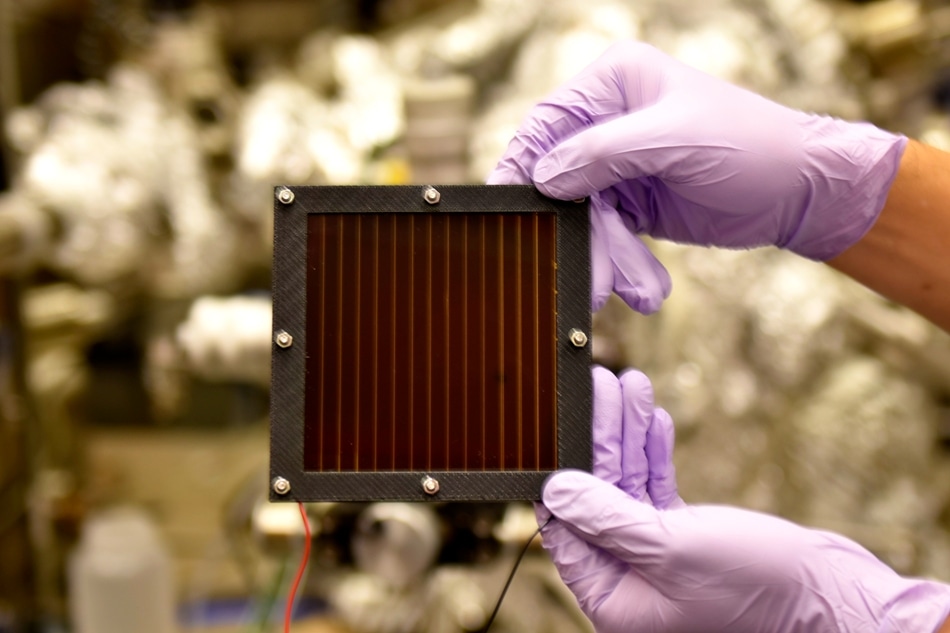Jun 18 2019
Researchers from the Okinawa Institute of Science and Technology Graduate University (OIST) state that a protective layer of epoxy resin will help arrest leakage of pollutants from perovskite solar cells (PSCs).
 This perovskite solar module is better able to contain the lead within its structure when a layer of epoxy resin is added to its surface. This approach to tackling a long-standing environmental concern helps bring the technology closer to commercialization. (Image credit: Okinawa Institute of Science and Technology Graduate University (OIST))
This perovskite solar module is better able to contain the lead within its structure when a layer of epoxy resin is added to its surface. This approach to tackling a long-standing environmental concern helps bring the technology closer to commercialization. (Image credit: Okinawa Institute of Science and Technology Graduate University (OIST))
Incorporating a “self-healing” polymer to the top of a PSC can drastically decrease how much lead it releases into the environment. This provides a robust boost to prospects for marketing the technology.
With carbon dioxide levels in the air touching their maximum recorded levels in history, and extreme weather events continuing to increase in number, the world is shifting from legacy energy systems banking on fossil fuels towards renewables like solar. Perovskite solar technology has potential, but one core challenge to commercialization is that it may discharge pollutants such as lead into the air — particularly under extreme weather situations.
“Although PSCs are efficient at converting sunlight into electricity at an affordable cost, the fact that they contain lead raises considerable environmental concern,” explains Professor Yabing Qi, head of the Energy Materials and Surface Sciences Unit, who led the research, published in Nature Energy.
“While so-called ‘lead-free’ technology is worth exploring, it has not yet achieved efficiency and stability comparable to lead-based approaches. Finding ways of using lead in PSCs while keeping it from leaking into the environment, therefore, is a crucial step for commercialization.”
Testing to destruction
Qi’s team, supported by the OIST Technology Development and Innovation Center’s Proof-of-Concept Program, first investigated encapsulation techniques for incorporating protective layers to PSCs to understand which materials might properly arrest the leakage of lead. They exposed cells encapsulated with various materials to a number of conditions intended to mimic the kinds of weather in which the cells would be exposed in real life.
They sought to test the solar cells in a worst-case weather scenario, to get an idea of the maximum lead leakage that could take place. First, they smashed the solar cells using a large ball, imitating extreme hail that could damage their structure and cause lead to leak. Next, they drenched the cells with acidic water to mimic the rainwater that would carry leaked lead into the environment.
The team examined the acidic rain using mass spectroscopy to establish how much lead seeped out of the cells. They discovered that an epoxy resin layer provided negligible lead leakage — orders of magnitude lower than the other materials.
Enabling commercial viability
Epoxy resin also worked best under several weather conditions in which rainwater, sunlight, and temperature were changed to mimic the environments in which PSCs must function in. In all settings, including very heavy rain, epoxy resin outdid competing encapsulation materials.
Epoxy resin worked really well because of its “self-healing” properties. After its structure is broken down by hail, for instance, the polymer somewhat reforms its initial shape when heated by sunlight. This restricts the amount of lead that leaks out of the cell. This self-healing property could render epoxy resin as the preferred encapsulation layer for future photovoltaic products.
Epoxy resin is certainly a strong candidate, yet other self-healing polymers may be even better. At this stage, we are pleased to be promoting photovoltaic industry standards, and bringing the safety of this technology into the discussion. Next, we can build on these data to confirm which is truly the best polymer.
Professor Yabing Qi, Study Lead and Head of Energy Materials and Surface Sciences Unit, OIST
Apart from lead leakage, another trial will be to scale up perovskite solar cells into perovskite solar panels. While cells are only a few centimeters long, panels can extend a few meters, and will be more applicable to prospective consumers. The team will also begin to focus their attention on the old challenge of renewable energy storage.
Solar Cell Encapsulation